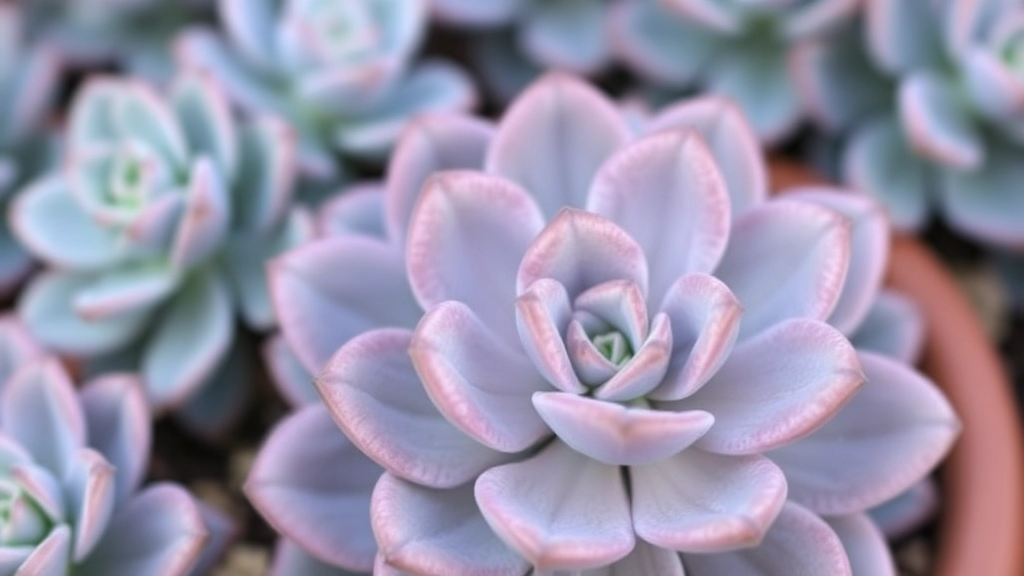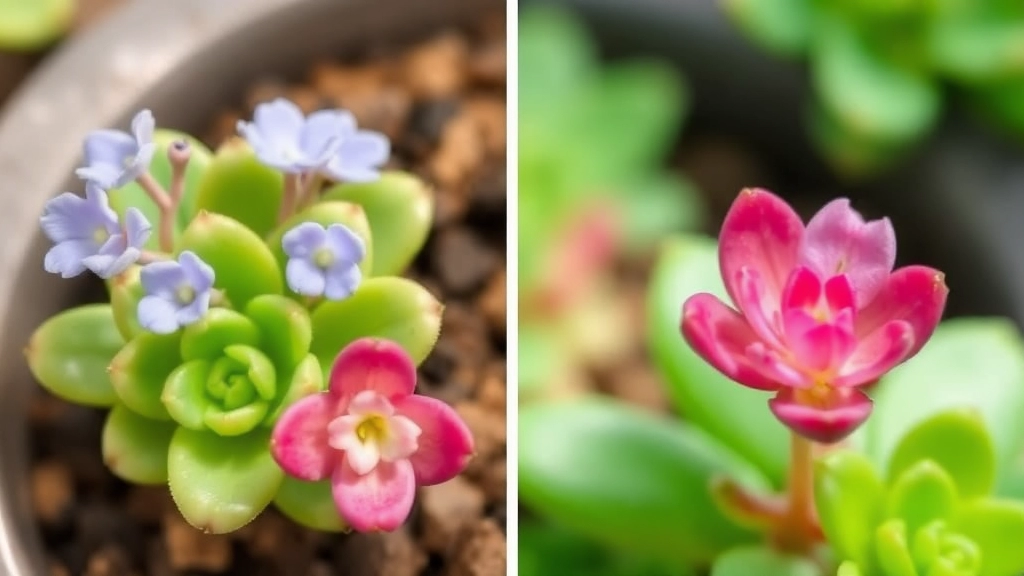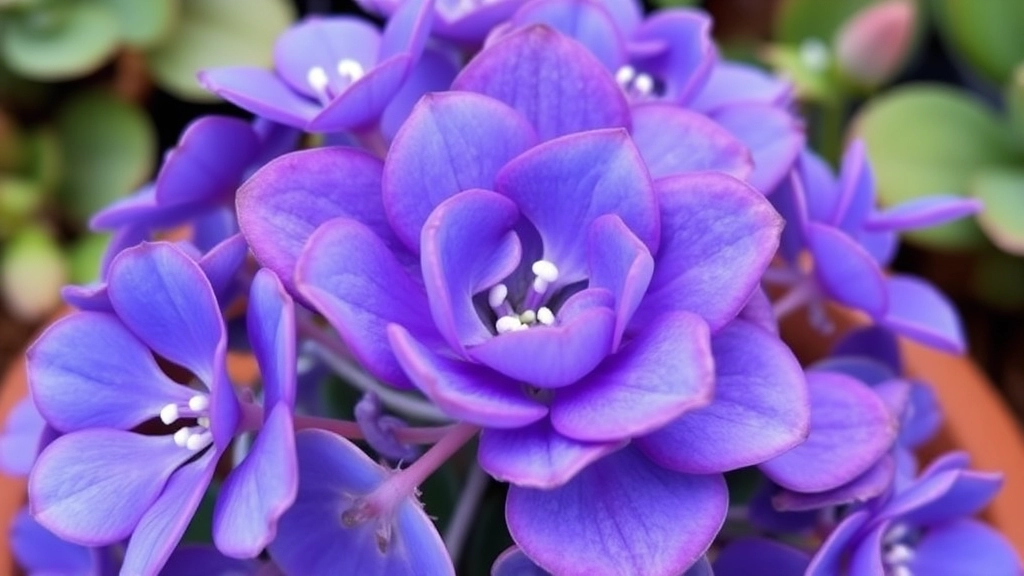Introduction to Blue Kalanchoe Succulent
If you’re a succulent enthusiast or a gardener on the lookout for something unique, the Blue Kalanchoe Succulent might just be the perfect addition to your collection. Known for its striking bluish foliage, this plant not only adds a pop of colour but also brings a touch of elegance to any garden or indoor space.
What to Expect in This Guide
In this article, we’ll dive into everything you need to know about Blue Kalanchoe Succulents. From identifying the different types available to essential care tips, light and watering requirements, propagation methods, and even troubleshooting common issues, we’ve got you covered. Whether you’re a newbie or a seasoned gardener, this guide will help you cultivate these stunning succulents with ease.
When considering adding Blue Kalanchoe succulents to your collection, you might wonder about the different types available. Each variety offers unique characteristics, making them suitable for various preferences and environments.
### Kalanchoe luciae (Flapjack Plant)
– **Description**: Known for its striking, paddle-shaped leaves that turn a vibrant blue-green, especially in bright light.
– **Size**: Can grow up to 30 cm tall and 45 cm wide.
– **Flowers**: Produces small, tubular flowers in clusters, typically in the spring.
### Kalanchoe thyrsiflora
– **Description**: Similar to the Flapjack, but with a more pronounced blue hue and a slightly more compact growth habit.
– **Size**: Generally reaches about 60 cm in height.
– **Flowers**: Displays bright yellow flowers that stand out against its blue foliage.
### Kalanchoe beharensis (Felt Plant)
– **Description**: Features thick, felt-like leaves with a silvery-blue tint, offering a unique texture.
– **Size**: Can grow quite large, up to 1 metre tall.
– **Flowers**: Produces small, bell-shaped flowers in a reddish hue.
For more detailed care instructions, you can refer to the [care tips for Kalanchoe beharensis](https://planthq.org/kalanchoe-beharensis-maltese-cross-care-growth-uses/).
### Kalanchoe ‘Blue Butterfly’
– **Description**: A hybrid known for its stunning blue leaves that resemble butterfly wings.
– **Size**: Typically remains smaller, making it ideal for indoor settings.
– **Flowers**: Blooms with bright orange flowers, creating a beautiful contrast.
### Kalanchoe ‘Blue Star’
– **Description**: Offers star-shaped leaves that are a striking blue-green, adding interest to any garden.
– **Size**: Generally grows between 30-40 cm tall.
– **Flowers**: Produces clusters of small pink flowers.
If you’re interested in other Kalanchoe varieties, check out the [types of Kalanchoe tomentosa](https://planthq.org/types-of-kalanchoe-tomentosa-varieties-and-care-tips/).
Essential Care Tips for Blue Kalanchoe Succulents

So, you’ve brought home a Blue Kalanchoe, and now you’re wondering how to keep it thriving?
Don’t worry, I’ve got you covered with some essential care tips that’ll make your succulent shine.
1. Soil Matters
- Well-Draining Soil: Use a cactus or succulent mix. This helps prevent root rot.
- DIY Option: Mix regular potting soil with sand or perlite for drainage.
2. Water Wisely
- Let It Dry: Always let the soil dry out between waterings.
- Check the Leaves: If they start to look wrinkly, it’s time for a drink.
- Watering Schedule: In summer, every 2-3 weeks works. In winter, less often.
3. Temperature Control
- Ideal Range: Keep it between 15°C to 25°C.
- Avoid Frost: These succulents don’t like the cold, so bring them indoors if it drops below 10°C.
4. Fertilising Fun
- Feed Sparingly: Use a diluted succulent fertiliser during the growing season (spring and summer).
- Frequency: Once a month is usually enough.
5. Pruning and Grooming
- Remove Dead Leaves: This helps prevent pests and keeps your plant looking fresh.
- Shape It Up: If it gets leggy, trim back the stems for a fuller look.
6. Pest Patrol
- Watch for Pests: Keep an eye out for mealybugs and aphids.
- Natural Solutions: A mixture of water and dish soap can help knock them out.
Light and Watering Requirements
When caring for Blue Kalanchoe succulents, one of the most common concerns is ensuring they receive the right amount of light and water.
Light Requirements
Blue Kalanchoe thrives in bright, indirect sunlight. Here are some key points to remember:
- Optimal Light: Aim for at least 6 hours of light daily. A south or west-facing window is ideal.
- Avoid Direct Sun: While they love light, too much direct sunlight can scorch their leaves.
- Signs of Insufficient Light: If your plant becomes leggy or the colours fade, it may not be getting enough light. For more tips on lighting, check out our guide on fixing etiolated Kalanchoe Blossfeldiana.
Watering Requirements
Watering is equally crucial for the health of your Blue Kalanchoe. Here’s how to get it right:
- Soil Check: Always check the top inch of soil before watering. If it feels dry, it’s time for a drink.
- Watering Frequency: Generally, water every 2-3 weeks, but this can vary based on your climate and season.
- Drainage: Ensure your pot has drainage holes. Overwatering can lead to root rot, a common issue for succulents. For more details on avoiding overwatering, visit our Kalanchoe Tomentosa watering guide.
Propagation Methods for Blue Kalanchoe

When considering how to propagate your Blue Kalanchoe, you might wonder about the best methods to ensure success. Propagation can be a rewarding process, allowing you to expand your collection or share plants with friends. Here are some effective techniques to consider:
1. Leaf Cuttings
- Select a Healthy Leaf: Choose a mature, healthy leaf from the parent plant.
- Cut and Dry: Use a clean, sharp knife to cut the leaf. Allow it to dry for a few days until the cut end forms a callus.
- Plant the Leaf: Place the callused end in well-draining soil, ensuring it’s upright. Water sparingly until roots develop.
2. Stem Cuttings
- Choose a Stem: Look for a healthy stem with several leaves.
- Make the Cut: Cut the stem just below a leaf node.
- Dry and Plant: Let the cutting dry for a day, then plant it in soil. Water lightly until new growth appears.
3. Offsets
- Identify Offsets: These are small plants that grow at the base of the parent plant.
- Remove Carefully: Gently twist or cut the offset away from the main plant, ensuring some roots are attached.
- Replant: Place the offset in its own pot with fresh soil, watering lightly.
4. Seeds
- Collect Seeds: If your Blue Kalanchoe flowers, you can collect seeds from the blooms.
- Sow in Soil: Sprinkle seeds on the surface of moist, well-draining soil.
- Provide Light: Keep the soil moist and place it in a sunny spot until germination occurs.
Propagation can seem daunting, but with these straightforward methods, you can easily grow new plants. The key is to be patient and provide the right conditions for each method.
Common Issues and How to Solve Them
When caring for Blue Kalanchoe succulents, you may encounter a few common issues that can hinder their growth and vibrancy. Understanding these problems and their solutions can help keep your plants thriving.
1. Overwatering
One of the most frequent problems with Blue Kalanchoe is overwatering. This succulent prefers dry conditions, and too much moisture can lead to root rot.
- Signs: Yellowing leaves, mushy stems.
- Solution: Allow the soil to dry completely between waterings. If root rot is suspected, repot the plant in fresh, dry soil and remove any affected roots. For more detailed guidance, refer to our best practices for watering Kalanchoe Tomentosa.
2. Underwatering
Conversely, underwatering can also pose a challenge.
- Signs: Wrinkled or shrivelling leaves.
- Solution: Water the plant thoroughly, allowing excess water to drain out. Establish a consistent watering schedule, especially during warmer months. You might also find our care tips for Kalanchoe succulents helpful in maintaining a healthy watering routine.
3. Insufficient Light
Blue Kalanchoe thrives in bright, indirect sunlight.
- Signs: Stretching or leggy growth, pale leaves.
- Solution: Move your plant to a brighter location, ensuring it gets at least six hours of light daily.
4. Pests
Pests like mealybugs and aphids can invade your succulent, causing stress.
- Signs: Sticky residue, visible insects on leaves.
- Solution: Treat with insecticidal soap or neem oil. Regularly inspect your plants to catch infestations early.
5. Fungal Infections
Humidity can lead to fungal problems, particularly in overly damp conditions.
- Signs: White powdery spots, wilting leaves.
- Solution: Improve air circulation around the plant and reduce watering frequency. Fungicides can also be applied if necessary.
By being aware of these common issues, you can take proactive steps to ensure your Blue Kalanchoe remains healthy and beautiful.
Best Varieties for Indoor and Outdoor Gardens
So, you’re thinking about adding some Blue Kalanchoe to your space? Great idea! These beauties can really brighten up your home or garden. But which varieties should you choose for indoor versus outdoor settings? Let’s break it down.
Indoor Varieties
- Kalanchoe blossfeldiana
- Known for its vibrant blooms.
- Compact size makes it perfect for windowsills.
- Blooms in various shades, including blue.
- Kalanchoe luciae (Paddle Plant)
- Unique, paddle-shaped leaves with a lovely blue hue.
- Thrives in bright, indirect light.
- Adds a modern touch to any indoor space.
- Kalanchoe tomentosa (Panda Plant)
- Soft, fuzzy leaves with a hint of blue.
- Low maintenance and perfect for beginners.
- Great for small pots and shelves.
Outdoor Varieties
- Kalanchoe beharensis (Elephant Bush)
- Larger, more robust plant.
- Ideal for outdoor gardens with plenty of sunlight.
- Can grow quite tall, making it a standout feature.
- Kalanchoe fedtschenkoi (Mother of Thousands)
- Spreading habit, perfect for ground cover.
- Produces tiny offsets, creating a lush look.
- Loves full sun and can tolerate drought.
- Kalanchoe serrata
- Beautiful serrated leaves with a bluish tint.
- Grows well in gardens with well-draining soil.
- Attracts pollinators, adding life to your garden.
Choosing the Right Variety
When selecting your Blue Kalanchoe, consider your space and light availability.
- For indoors, look for compact varieties that won’t outgrow your space.
- For outdoors, opt for hardier types that can withstand the elements.
If you’re interested in more detailed care tips, check out our Kalanchoe blossfeldiana leaf care tips and our guide on how to propagate Kalanchoe tomentosa.
FAQs About Blue Kalanchoe Succulents
What type of soil is best for Blue Kalanchoe succulents?
Blue Kalanchoe succulents thrive in well-draining soil. You can use a cactus or succulent mix, or create your own by mixing regular potting soil with sand or perlite.
How often should I water my Blue Kalanchoe?
It’s important to let the soil dry out between waterings. In summer, watering every 2-3 weeks is usually sufficient, while in winter, you should water less frequently. If the leaves start to look wrinkly, it’s time to water.
What temperature range is ideal for Blue Kalanchoe succulents?
These succulents prefer temperatures between 15°C to 25°C. They are sensitive to cold and should be brought indoors if the temperature drops below 10°C.
How often should I fertilize my Blue Kalanchoe?
Use a diluted succulent fertilizer once a month during the growing season (spring and summer). Feed sparingly to avoid over-fertilizing.
How do I prune and groom my Blue Kalanchoe?
Regularly remove dead leaves to prevent pests and keep the plant looking fresh. If the plant becomes leggy, trim back the stems to encourage a fuller appearance.
What should I do if my Blue Kalanchoe gets pests?
Keep an eye out for common pests like mealybugs and aphids. A natural solution is to use a mixture of water and dish soap to eliminate them.
What are the methods to propagate Blue Kalanchoe?
There are several methods to propagate Blue Kalanchoe, including:
- Leaf Cuttings: Select a healthy leaf, cut and let it dry to form a callus, then plant it in well-draining soil.
- Stem Cuttings: Choose a healthy stem, cut just below a leaf node, let it dry, and then plant it in soil.
- Offsets: Identify and carefully remove offsets from the base of the parent plant, then replant them in fresh soil.
- Seeds: Collect seeds from the blooms, sprinkle them on moist, well-draining soil, and provide light until germination.
How long does it take for Blue Kalanchoe to root from cuttings?
The rooting process can vary, but generally, you should see roots developing within a few weeks. Patience and proper care are key to successful propagation.
Can Blue Kalanchoe be grown indoors?
Yes, Blue Kalanchoe can be grown indoors as long as it receives plenty of light and is kept in a suitable temperature range. Ensure it is placed in a well-lit area, preferably with indirect sunlight.
References
-
How to Grow Kalanchoe Succulents Indoors
-
Kalanchoe Succulent Care: How To Grow Kalanchoe Plants
-
Kalanchoe: How to Plant, Grow, and Care for Kalanchoe
